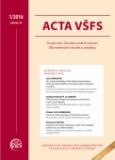Prediction of Emission Allowances Spot Prices Volatility with the Use of GARCH Models
Prediction of Emission Allowances Spot Prices Volatility with the Use of GARCH Models
Author(s): Daniela SpiesováSubject(s): Energy and Environmental Studies, Environmental and Energy policy, Policy, planning, forecast and speculation, Environmental interactions
Published by: Vysoká škola finanční a správní, a.s.
Keywords: emission allowance; volatility; ARIMA; GARCH; prediction; spot price;
Summary/Abstract: For several years, the system of emission allowances trading has been dealing with a crisis mainly due to the falling prices of emission allowances. That said, the partial aim of this paper is to create an overview of EUA trading options and acquaint readers with the development of the emission allowances price. Another partial aim is to predict the volatility of prices of emission allowances with the use of BAU scenario, i.e. without any intervention. ARIMA models are used to model the conditional mean value and linear ARCH or GARCH models are used to model conditional variance. The uniqueness of this paper lies in the fact that there are many expert studies dealing with the prediction of the price of allowance but there are only a limited number of scientific studies concerning the prediction of volatility which is the crucial element for trading with emission allowances on the exchange. Based on these two results the main aim of this article is to show possible malfunction of EU ETS in future based on the price development of EUA in time and on volatility prediction. The results of this study confirm that to predict the conditional variance and then volatility, it is adequate to use the cluster model AR(1,8,12)-GARCH(1, 1) without constant, where in the long-term, the square root of the conditional variance inclines towards stable value. Based on the analysis of EUA prices it is obvious that the system is not efficient and does not fulfill its purpose. These two partial conclusions suggest that in case of non-intervention of the European Commission the whole mechanism may fail.
Journal: Acta VŠFS - ekonomické studie a analýzy
- Issue Year: 10/2016
- Issue No: 1
- Page Range: 66-79
- Page Count: 14
- Language: English

